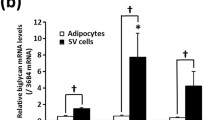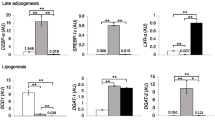Abstract
Background
Limited data are available on the in vivo expression of fibronectin, one of the main extracellular matrix components. We investigated the expression of fibronectin in abdominal visceral adipose tissue (VAT) and subcutaneous adipose tissue (SAT) and the associations of leptin, adiponectin, and vaspin gene expression with metabolic parameters in obese women.
Methods
We recruited female subjects undergoing bariatric surgery for obesity (n = 24) and patients undergoing benign gynecological surgery as the control group (n = 23). We measured anthropometric variables, abdominal fat distribution, metabolic parameters, serum concentrations of leptin, adiponectin, and vaspin, and depot-specific mRNA expression of fibronectin, leptin, adiponectin, and vaspin.
Results
Fibronectin expression in both VAT and SAT was significantly lower in the obese group than in the control group. Fibronectin expression in both VAT and SAT were negatively correlated with body mass index or waist circumference, with higher prominence in VAT. In multiple regression analysis, fibronectin expression in both VAT and SAT was negatively correlated with serum leptin concentration. Fibronectin expression in VAT was negatively correlated with leptin expression in VAT. Additionally, fibronectin expression in SAT was negatively correlated with leptin expression in SAT and positively correlated with adiponectin expression in VAT and SAT.
Conclusions
We found significant negative associations between depot-specific fibronectin expression in human adipose tissue and obesity indices and obesity-related biomarkers. Our results suggest that fibronectin expression may contribute to obesity and metabolic dysregulation in humans.
Similar content being viewed by others
References
Adams JC, Watt FM. Fibronectin inhibits the terminal differentiation of human keratinocytes. Nature. 1989;340:307–9.
Rutkowski JM, Davis KE, Scherer PE. Mechanisms of obesity and related pathologies: the macro- and microcirculation of adipose tissue. FEBS J. 2009;276:5738–46.
Pasarica M, Gowronska-Kozak B, Burk D, et al. Adipose tissue collagen VI in obesity. J Clin Endocrinol Metab. 2009;94:5155–62.
Divoux A, Tordjman J, Lacasa D, et al. Fibrosis in human adipose tissue: composition, distribution, and link with lipid metabolism and fat mass loss. Diabetes. 2010;59:2817–25.
Pankov R, Yamada KM. Fibronectin at a glance. J Cell Sci. 2002;115:3861–3.
Antras J, Hilliou F, Redziniak G, et al. Decreased biosynthesis of actin and cellular fibronectin during adipose conversion of 3T3–F442A cells. Reorganization of the cytoarchitecture and extracellular matrix fibronectin. Biol Cell. 1989;66:247–54.
Pierleoni C, Verdenelli F, Castellucci M, et al. Fibronectins and basal lamina molecules expression in human subcutaneous white adipose tissue. Eur J Histochem. 1998;42:183–8.
Taleb S, Cancello R, Clement K, et al. Cathepsin s promotes human preadipocyte differentiation: possible involvement of fibronectin degradation. Endocrinology. 2006;147:4950–9.
Yoshizumi T, Nakamura T, Yamane M, et al. Abdominal fat: standardized technique for measurement at CT. Radiology. 1999;211:283–6.
Matthews DR, Hosker JP, Rudenski AS, et al. Homeostasis model assessment: insulin resistance and beta-cell function from fasting plasma glucose and insulin concentrations in man. Diabetologia. 1985;28:412–9.
Novak M, Monkus E, Pardo V, et al. Preparation of subcellular fractions suitable for biochemical analyses from human subcutaneous adipose tissue obtained by needle biopsy. I. Isolation of mitochondria on a microscale. Exp Cell Res. 1972;73:335–44.
Rodriguez Fernandez JL, Ben-Ze'ev A. Regulation of fibronectin, integrin and cytoskeleton expression in differentiating adipocytes: inhibition by extracellular matrix and polylysine. Differentiation. 1989;42:65–74.
Spiegelman BM, Ginty CA. Fibronectin modulation of cell shape and lipogenic gene expression in 3T3–adipocytes. Cell. 1983;35:657–66.
Wang Y, Zhao L, Smas C, et al. Pref-1 interacts with fibronectin to inhibit adipocyte differentiation. Mol Cell Biol. 2010;30:3480–92.
Hsieh P, Chen LB. Behavior of cells seeded in isolated fibronectin matrices. J Cell Biol. 1983;96:1208–17.
Yamada KM, Yamada SS, Pastan I. Quantitation of a transformation-sensitive, adhesive cell surface glycoprotein. Decrease of several untransformed permanent cell lines. J Cell Biol. 1977;74:649–54.
Spiegelman BM, Green H. Control of specific protein biosynthesis during the adipose conversion of 3T3 cells. J Biol Chem. 1980;255:8811–8.
Miller RE, Carrino DA. An association between glutamine synthetase activity and adipocyte differentiation in cultured 3T3–L1 cells. Arch Biochem Biophys. 1981;209:486–503.
Steinberg MM, Brownstein BL. A clonal analysis of the differentiation of 3T3–L1 preadipose cells: role of insulin. J Cell Physiol. 1982;113:359–64.
Li Q, Hosaka T, Jambaldorj B, et al. Extracellular matrix with the rigidity of adipose tissue helps 3T3–L1 adipocytes maintain insulin responsiveness. J Med Investig. 2009;56:142–9.
Zhang W, Ambati S, Della-Fera MA, et al. Leptin modulated changes in adipose tissue protein expression in ob/ob mice. Obesity (Silver Spring). 2011;19:255–61.
Conflict of Interest
This research was supported by the Basic Science Research Program through the National Research Foundation of Korea (NRF), funded by the Ministry of Education, Science, and Technology (2012–004869) Seoul, Korea. Seoung Hee Lee, Hye Soon Park, Jung Ah Lee, Young Sook Song, Yeon Jin Jang, Jong-Hyeok Kim, Yeon Ji Lee, Yoonseok Heo declare that they have no conflicts of interest.
Author information
Authors and Affiliations
Corresponding authors
Rights and permissions
About this article
Cite this article
Lee, S.H., Park, H.S., Lee, J.A. et al. Fibronectin Gene Expression in Human Adipose Tissue and Its Associations with Obesity-Related Genes and Metabolic Parameters. OBES SURG 23, 554–560 (2013). https://doi.org/10.1007/s11695-012-0801-2
Published:
Issue Date:
DOI: https://doi.org/10.1007/s11695-012-0801-2




